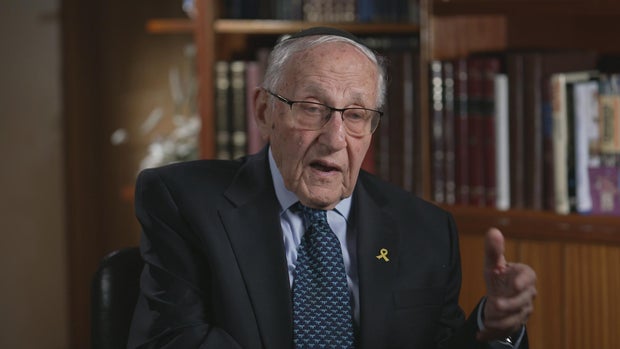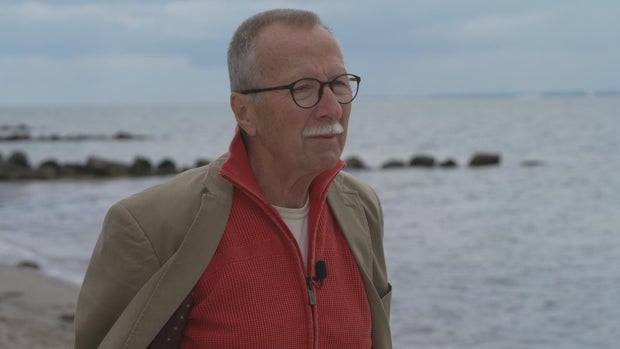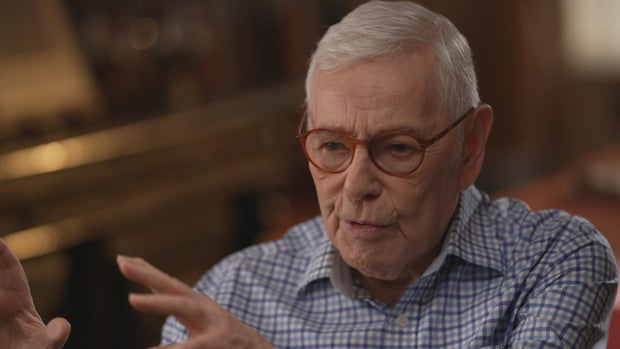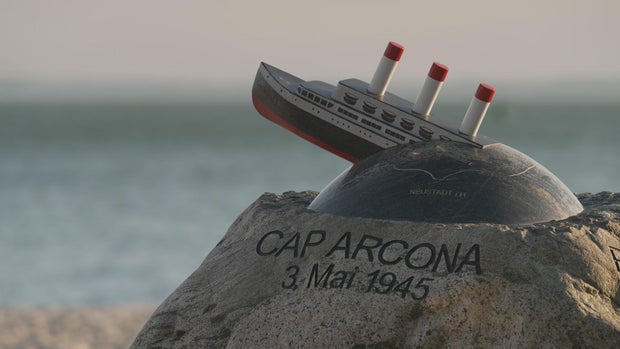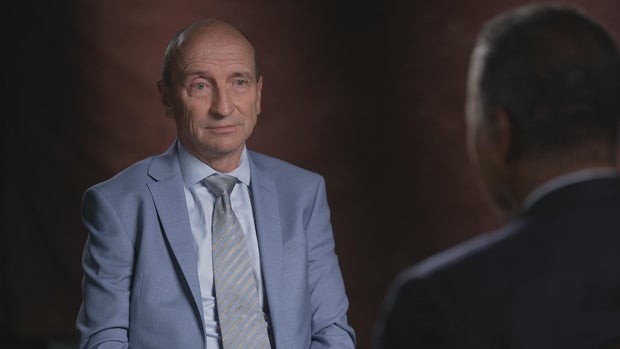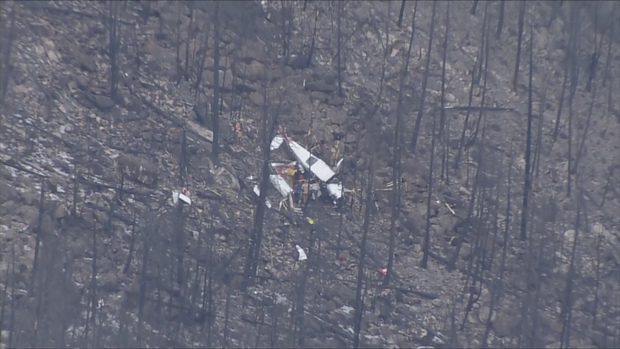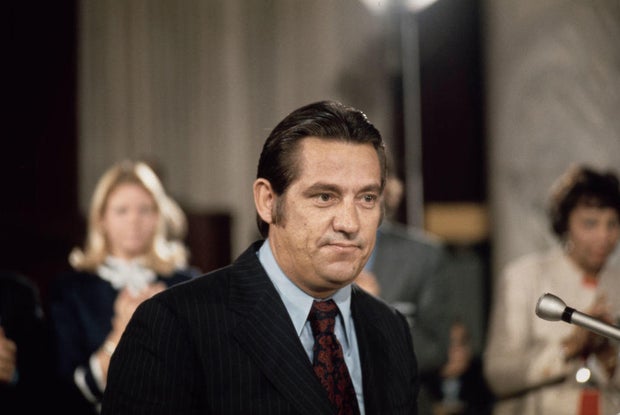CBS News
Victims’ families remember Nazi ship sunk with prisoners on board | 60 Minutes

Everyone knows the story of the Titanic, the opulent British ocean liner that struck an iceberg and sank. But it’s likely you have never heard of the Cap Arcona, a German version of the Titanic. Before World War II, the vessel was a cruise ship for the well-to-do. By the end of the war, the Nazis had transformed it into a floating concentration camp. Packed with prisoners, the Cap Arcona was anchored in Lübeck Bay in the Baltic Sea when an aerial attack just hours before liberation killed nearly everyone on board. The ship’s improbable journey from luxury liner to death trap is one of the most horrific and little known war stories we have encountered.
On sunlit days, Germany’s Baltic coast looks idyllic. But this beauty masks an unthinkable horror, one that’s etched in the local memory and on this beachside marker bearing the name Cap Arcona and the German words for fear, panic, and grief.
Bill Niven: It’s so calm, so peaceful. And yet out there is a graveyard. You can come to a place like this and just feel the weight of the history.
British historian Bill Niven has spent much of his career studying the Holocaust. We met him at Lübeck Bay, where the memory of the Cap Arcona and a smaller cargo ship bombed on May 3rd, 1945 … still haunts this shore.
Bill Whitaker: What is this place?
Bill Niven: This is a memorial– an honorary memorial to the victims of the two ships that went down, with a loss of some 7,000 lives.
Bill Niven: It recalls all the nationalities that were victims of the sinking of the ships.
Bill Whitaker: There were Americans on the ships?
Bill Niven: Yes. There were Greeks, there were Italians, and the Jewish people of course, represented here by the Star of David.
60 Minutes
Most of the victims were on the Cap Arcona. Every year on the anniversary of the attack, a somber ceremony is held at this site to remember those who perished … and those who suffered.
Bruno Neurath-Wilson: My father was one of the survivors of the sinking of the Cap Arcona.
Bruno Neurath-Wilson came to honor his father, Willi, a political prisoner held on the Cap Arcona. Only about 400 prisoners survived the attack, including Bruno’s father.
Bill Whitaker: What’s it like for you to be in this place?
Bruno Neurath-Wilson: When we go to the place where the Cap Arcona sank, I try to imagine what happened. I really cannot imagine what happened on the ship.
No one could have imagined this end for the Cap Arcona. Launched with great fanfare in 1927, the ship became known as the “Queen of the Atlantic,” transporting well-heeled passengers from Europe to South America in two weeks.
Bill Whitaker: What was it like in its heyday?
Bill Niven: Well, it was one of the most beautiful ships the Germans had. It had its own tennis court. It had a heating swimming pool. It had the most wonderful restaurant where you could look out onto the sea. The most wonderful first-class cabins.
Bill Whitaker: It was a luxury– a luxury cruise ship?
Bill Niven: It was a luxury, luxury cruise liner. Absolutely was.
The Cap Arcona traversed the Atlantic dozens of times. But in 1933, Germany underwent a sea change.
Adolf Hitler came to power.
In 1939, as German troops invaded Poland, the Nazis commandeered the Cap Arcona to serve as a floating barracks in the Baltic. Ironically, on one of its last trips before the war, the ocean liner carried some German Jewish passengers who had bought tickets to safety in South America. But most Jews had no way to escape.
Manfred Goldberg: We were rounded up and sent to the concentration camp, just the three of us, my mother, I, and my younger brother.
94-year-old Manfred Goldberg was just 11 when the Nazis forcibly removed him and other Jews from his hometown of Kassel in central Germany. He would survive confinement in the Riga, Latvia ghetto and four different concentration camps.
60 Minutes
Manfred Goldberg: The cruel experiences during my young years between 11 and 15, they’re firmly lodged clearly in my mind to this day.
In Nazi-held Latvia, Goldberg, his mother Rosa and other prisoners were forced to repair bombed out railroad tracks during the day. When they returned to camp one night, they learned the SS had taken Manfred’s little brother Hermann, and three other children. They were never seen again.
Manfred Goldberg: They just disappeared off the face of the Earth. The next morning, both my mother and I had to line up and go to work as though nothing untoward had happened.
Bill Whitaker: What did that do to you and your mother?
Manfred Goldberg: I was nearly as heartbroken as my mother at the loss of her little baby, so to speak. He was seven when he went into the camps and nine the day he disappeared.
Goldberg and his mother ended up in the Stutthof camp in Nazi-occupied Poland. Another young boy, George Schwab, was imprisoned there, too.
George Schwab: The crematorium burning, you know, bodies all the time, gassing them. Terrible.
Schwab is 92, but he was only 9 when German soldiers invaded his hometown of Liepāja, Latvia. Schwab’s father, a prominent physician, tried to protect other Jews in town.
George Schwab: He noticed SS trucks were approaching, and he waved for fellow Jews to disperse and they arrested him, knocked out one eye, threw him down the cellar, and then killed him.
Bruno’s father, Willi Neurath, was not Jewish, but he actively opposed the Nazi regime.
Bruno Neurath-Wilson: My parents belonged to the small minority of German people who fighted against the Nazis. They didn’t fight with weapons, of course.
Bill Whitaker: Fight with their words?
Bruno Neurath-Wilson: Yes. Fighting with papers, with printed papers.
Willi was arrested for distributing anti-facist fliers.
Bruno Neurath-Wilson: They brought him to Buchenwald. And– from Buchenwald, they brought him to the concentration camp Neuengamme by Hamburg.
60 Minutes
The Neuengamme work camp mostly held political prisoners. Inside this massive warehouse, historian Bill Niven told us prisoners like Willi Neurath made bricks.
Bill Whitaker: What does it feel like to walk in here?
Bill Niven: It feels like a factory of death. You can sense what went on in this place.
Bill Whitaker: But this was not a death camp, this was a work camp.
Bill Niven: It’s a very, very slim distinction. In the course of this work, they die. They die in droves.
Willi Neurath managed to survive but, as fate would have it, he, Schwab, the Goldbergs, and the Cap Arcona all would end up at Lübeck Bay, one of the last Nazi defensive positions.
In 1945, as the Allies were closing in, the Cap Arcona – now rusted and battered – was repositioned to Lübeck Bay. At the same time, SS Chief Heinrich Himmler ordered the evacuation of concentration camps.
Bill Whitaker: Why were they trying to clear these places out?
Bill Niven: There is an order by Himmler that no prisoner is to be delivered into the hands of the enemy alive. But I think the main concern was to get rid of evidence because prisoners are evidence. They can talk. They can tell. They can speak to those atrocities that were committed by the Nazis. So getting rid of the evidence meant getting rid of human beings.
Thousands of prisoners were sent to the Nazi holdout at Lübeck Bay. Willi Neurath was forced north from Neuengamme, about 50 miles. From Stutthof in the east, Manfred Goldberg, his mother, and George Schwab were sent to a nearby town, aptly named Hel, and put on barges.
Bill Whitaker: What were the conditions?
George Schwab: Oh, terrible. Just beyond description. No toilet facilities. Hardly any food. You could hardly sit, you can certainly not sleep.
Bill Whitaker: It sounds like hell.
George Schwab: Hell. Hell on Earth, absolutely.
The barges, each packed with about a thousand prisoners, were towed by tugboat for six days, about 400 miles across the Baltic to where the Cap Arcona was positioned.
The Cap Arcona arrived in Lübeck Bay on April 14, 1945, two weeks before Hitler killed himself and three weeks before the end of the war in Europe. It was anchored out there, about 2 miles offshore. With its engines barely running and little in the way of food and water, the former Queen of the Atlantic – a playground for the rich and famous – was about to become a floating concentration camp.
With nowhere to hold the amassed prisoners, SS guards jammed more than 4,000, including Willi Neurath, onto the Cap Arcona.
Bill Niven: And one must remember this is a ship that’s meant for 1,500 people. It’s not meant for 4-5,000 prisoners.
Bill Whitaker: Do we know what the Nazis intended to do with the prisoners on the ship?
Bill Niven: I think they intended them to die.
Prisoners already were dying on the barges fleeing Stutthof carrying Schwab and the Goldbergs. Once in the bay, the SS guards uncoupled the tugboats, leaving the prisoners adrift.
Bill Whitaker: They just abandoned you?
George Schwab: Abandoned. We were left alone, supposedly on minefields.
60 Minutes
Schwab and Goldberg told us, mixed in with the concentration camp victims, were a few prisoners of war. They had been better fed and better treated and they seized the opportunity.
Manfred Goldberg: They managed to pry loose some very long floorboards and began using these planks of wood as oars. And they rowed in that manner into the night. Shortly before dawn the barge run aground.
Norwegian prisoners on George Schwab’s barge took advantage of the wind blowing toward shore.
George Schwab: They came and collected the blankets that we had and made sails. And we managed to sail towards land.
Near death, but desperate to live, Schwab and the Goldbergs found the strength to climb out of their barges … only to be intercepted by the SS and German troops on the beach, who shot and killed many prisoners on the spot.
Manfred Goldberg: And we felt practically certain that we would be shot next. But instead they lined us up into a column.
George Schwab: We were told that we were going to be shipped to a liner by the name of Cap Arcona.
Manfred Goldberg: And while we stood there, we saw quite a large number of bombers, airplanes, moving overhead.
At the beginning of May 1945, the war in Europe was all but over. Adolf Hitler was dead, German forces were in retreat, and the Third Reich was crumbling. One of the last Nazi defensive positions was at Lübeck Bay in the Baltic Sea, where German ships fled seeking safe harbor – including the Cap Arcona, a luxury ocean liner commandeered by the Nazis for the war effort. As the Allies closed in, the SS evacuated concentration camps and packed thousands of prisoners onto the Cap Arcona.
Around noon on May 3rd 1945, 13-year-old George Schwab was ordered to line up to board the ship.
George Schwab: But the Cap Arcona could not come close to shore, because it was a large liner.
Bill Whitaker: It’s a big ship.
George Schwab: So we were going to be transported to the Cap Arcona by another ship. I was in the back of the line. I was in no hurry.
Bill Whitaker: You purposely got to the back of the line–
George Schwab: Back– back of the line.
He was at a dock near this German naval base, where Manfred Goldberg and his mother were lined up too.
Manfred Goldberg: And it is while we stood there that we witnessed bombers, and fighter planes coming along.
Bill Whitaker: Could you see any markings on the planes?
Manfred Goldberg: No. We had no idea what nationality they were.
Bill Whitaker: You could see the planes coming in.
Manfred Goldberg: Oh, you could see the planes clearly.
Bill Whitaker: And you could– you could– see the bombs be–
Manfred Goldberg: You could see the bombs dropping.
Bill Whitaker: Can you remember what it sounded like?
Manfred Goldberg: There were some pretty powerful explosions, and there were quite a few.
60 Minutes
The Cap Arcona was hit. With more than 4,000 prisoners on board, the floating concentration camp became a fiery tomb. In a hard-to-believe turn of events, the attackers were British Typhoon fighters like these, part of the Allied forces moving in to finish off the Nazis.
Bill Whitaker: The British came to liberate these prisoners–
Bill Niven: They did, yeah.
Bill Whitaker: And ended up killing–
Bill Niven: Yeah.
Bill Whitaker: –thousands of them. It’s like horror on top of horror.
Bill Niven: It is. And yet, some of them did survive to remember it.
Bill Niven is a British historian and scholar of the Holocaust. He told us the mistaken attack on the Cap Arcona and a smaller ship is one of the most wrenching tragedies of the war.
Bill Niven: The prisoners– knew that the war was nearing its end. I think a lot of them probably had hopes that they would survive, and that gave them the strength and the courage to hang on.
At the Cap Arcona museum in the town of Neustadt by Lübeck Bay, he described the attack. British Typhoons struck in waves. The Cap Arcona was hit around 3 p.m.
Bill Whitaker: Do you have any idea how many bombs were dropped on the ship?
Bill Niven: Some people say 60 or over 60. You can imagine the panic and the horror that broke out when the bombs hit the ship, especially for those concentration camp prisoners who were on the very lower decks of the ship. And they were unable to get up– to the top because of the flames.
Bill Whitaker: Is this the worst case of friendly fire in the Royal Air Force’s history?
Sebastian Cox: Quite probably, yeah.
Sebastian Cox is chief historian for Britain’s Royal Air Force … the RAF. He blames the incident on the fog of war.
Bill Whitaker: Why was the Cap Arcona– targeted?
60 Minutes
Sebastian Cox: Because– the Allies believed that there was gonna be an attempt to flee– by certain Nazi elements across the Baltic to Norway and, and essentially continue the war.
Bill Whitaker: Did the British military have any idea that concentration camp survivors were on the Cap Arcona?
Sebastian Cox: If you mean, “Did the pilots have any idea,” absolutely not.
But other members of the British military did know.
Daniel Long: What we learned from the records that the British were handed two opportunities very close to the 3rd of May in regards to the placement of prisoners on board the ship.
Bill Whitaker: Concentration camp prisoners on those ships.
Daniel Long: Indeed.
Daniel Long wrote his PhD history thesis on the attack on the Cap Arcona. We met him at the British National Archives in London where he showed us these fragile war documents.
Daniel Long: This is the only official investigation that was carried out into the tragic sinking of the Cap Arcona.
Shortly after the bombing a British war crimes investigator interviewed the intelligence officer for the squadrons that attacked the Cap Arcona and other ships in the bay.
Daniel Long: The intelligence officer admitted on two occasions that a message was received on the second of May, 1945, that the ships had been loaded with concentration camp prisoners.
That intelligence came in the day before the attack.
Daniel Long: Which then leads to suggest there was ample time to warn the pilots on the planes.
Bill Whitaker: That information did not make it t– to the RAF pilots.
Daniel Long: That’s– that’s correct.
60 Minutes
The report does not say why the intelligence officer failed to inform the pilots, but it did blame RAF personnel for the error and called for further inquiry.
Bill Whitaker: The report strongly urged that there be a follow-up investigation. That has never happened, has it?
Sebastian Cox: Not to my knowledge.
Bill Whitaker: Why not?
Sebastian Cox: Attempting to, you know, conduct a detailed investigation would, in many respects, be a little pointless. What are– what are you going to conclude? You’ve–
Bill Whitaker: To find out what went wrong, what mistakes were made?
Sebastian Cox: We know what happened. The RAF made a mistake. An individual made a very tragic mistake and we know the consequences.
About 7,000 prisoners perished when the ships were bombed in the bay. Of the more than 4,000 on the Cap Arcona, only about 400 survived. Bill Niven told us several survivors later wrote accounts of the hell they endured at sea.
Bill Niven: (Reading from German document)
Bill Niven: Thousands of prisoners were packed together like herrings.
Bill Niven: (Reading from German document)
Bill Niven: So they stretched their arms up then they cried out, “I want out. I want out.” This is really quite terrible, to have to read this. The fire suddenly got more and more intensive, and this was because the flesh of the prisoners was burning so strongly. It made this intensity happen. It’s distressing to read.
Bruno Neurath-Wilson’s father Willi, a political prisoner, was trapped on the ship when the bombs hit.
Bruno Neurath-Wilson: My father– managed to go to the back– of the ship, where it was not burning. And there he survived be– because he couldn’t swim.
Bill Whitaker: He survived because he couldn’t swim?
Bruno Neurath-Wilson: He couldn’t swim be– he did not jump into the water. And prisoners who jumped into the water were shot by the SS.
When the British realized their mistake, they dispatched rescuers who plucked Willi Neurath and others from the listing deck of the Aap Arcona and took them to shore.
Bill Whitaker: This is the stretch of beach where your father came ashore.
Bruno Neurath-Wilson: This front of the beach, yes.
Bruno told us, in an improbable twist of fate, his mother Eva, a naval staff assistant, had been transferred to the naval base at Lübeck Bay. When she saw the bombing, she was drawn to the beach.
Bruno Neurath-Wilson: She had only one hope to know: Where is my husband? Is he still living? And maybe my husband is on the ship.
Bill Whitaker: How did they find each other?
Bruno Neurath-Wilson: She came from this direction and she saw a man coming towards her. She didn’t recognize the one person she wanted to see.
Bill Whitaker: He must have been thin and weak.
Bruno Neurath-Wilson: And dirty from the burning. But he came over to her, and– called his nickname he had for her, Muppel.
Bill Whitaker: What does Muppel mean?
Bruno Neurath-Wilson: Muppel means something like, “I love your round face.” She recognized his voice by this one word, “Muppel.”
Bill Whitaker: That ship was a graveyard for so many people. But yet it brought your parents back together.
Bruno Neurath-Wilson: Yeah. I don’t know if there are hidden meanings in life. But one meaning can be that I am– I am alive now and can tell you about this story.
As for George Schwab, he pulled inspiration from the horror.
George Schwab: This is a prize for having helped Latvia get into NATO.
The native of Latvia moved to New York, earned a PhD in political science, and had an illustrious career as an academic and peace broker.
George Schwab: Here I’m with King Hussein.
Bill Whitaker: Bill Clinton.
George Schwab: –and Bill Clinton.
Bill Whitaker: Dr. Schwab, I think you knew everyone.
George Schwab: Somewhat (laugh)
Manfred Goldberg and his mother settled in London. She passed away in 1961. Goldberg married, started a business and a family. In 2017 he returned to the Stutthof Concentration Camp with the then duke and duchess of Cambridge. He has made it his life mission to share his story.
Manfred Goldberg: I consider that part of my revenge on the Nazis. They wanted to exterminate us. And here we are, not only having survived, we are now great-grandparents.
Bill Whitaker: That’s your revenge.
Manfred Goldberg: My revenge on the Nazis, yes.
The Cap Arcona lay half-sunken in Lübeck Bay for four years before being dismantled. But the story has lain beneath the surface – little known beyond this Baltic Coast. It’s now tradition, on the third of May, for families of victims and survivors to sail to the site where the ship was bombed. They want the world to remember.
Produced by Marc Lieberman. Associate producer, Cassidy McDonald. Field associate producer, Anna Noryskiewicz. Broadcast associate, Mariah Johnson and Mariah B. Campbell. Edited by Warren Lustig.
CBS News
Marta’s Orlando Pride defeat Washington Spirit for their first NWSL title

Barbra Banda scored in the 37th minute to give the Orlando Pride their first National Women’s Soccer League championship with a 1-0 victory over the Washington Spirit on Saturday night.
Banda dribbled into the right side of the box and made a move past a defender before kicking the ball on the ground with her left foot and past the goalkeeper. She became the first player in the NWSL to score in each round of the playoffs.
The Pride’s Angelina was nearly called for a push before passing it to Banda, but the VAR determined that the play was fair.
Kyle Rivas / Getty Images
The Spirit (20-7-2) controlled the game and outshot the Pride 25-9, had two more shots on goal and held onto possession 58% of the time. Rosemonde Kouassi had Washington’s best chance in the 47 minute when she headed a ball from about 10 yards away.
Orlando’s win gave Brazilian star Marta her first NWSL title. The 38-year-old Marta, considered arguably the greatest female soccer player of all time, joined the Orlando Pride in 2017 but had never reached an NWSL championship game until this year.
“(It’s a) magic moment for me because I’ve been in this club for so long and (to) wait for this moment, you know, so it’s… I’m just enjoy every single moment,” she told CBS News Friday ahead of the game. “…This year become like the best year in my club life.”
Top-seed Orlando (21-6-2) went unbeaten in its first 23 matches, a league record. They beat the Kansas City Current in the semifinals before hoisting the trophy at CPKC Stadium, their home field.
Orlando is the first team since 2019 to win the Shield and the title in the same year.
Washington had won its last five playoff games when trailing at the half, but that streak was broken with this loss.
CBS News
2 killed in U.S. Civil Air Patrol plane crash near Palisade Mountain in Northern Colorado

Two people were killed and a third was injured when a U.S. Civil Air Patrol plane crashed in Colorado’s Front Range Saturday morning.
The small passenger plane with three people aboard crashed near Storm Mountain and Palisade Mountain west of Loveland around 11:15 a.m., according to the Larimer County Sheriff’s Office. The plane belonged to the Civil Air Patrol, the civilian auxiliary wing of the U.S. Air Force, and was on a routine aerial photography training mission when it went down, officials said.
Pilot Susan Wolber and aerial photographer Jay Rhoten were identified by CAP as those killed and co-pilot Randall Settergren was identified as the person injured. Settergren was airlifted to an area hospital by a National Guard helicopter, where he is undergoing medical care.
CBS
“The volunteers of Civil Air Patrol are a valuable part of the Department of Military and Veterans Affairs, and the lifesaving work they do on a daily basis directly contributes to the public safety of Coloradans throughout the state,” Maj. Gen. Laura Clellan, adjutant general of the Colorado Department of Military and Veterans Affairs, said in a statement Saturday.
“We are devastated to hear of the loss of Susan Wolber and Jay Rhoten, and the injury of Randall Settergren, during a training mission in Larimer County. Our thoughts and deepest condolences are with the families of those involved in the crash,” Clellan continued. “I would also like to thank all of the first responders who assisted with rescue efforts.”
Palisade Mountain is in Larimer County, about 20 miles west of Loveland and about 65 miles northwest of Denver. The area is part of the burn scar of the Alexander Mountain Fire, which burned almost 10,000 acres in over two weeks this past summer.
The crash happened about 200 feet below the summit of Palisade Mountain in an area that includes tall trees and steep hills as part of the mountain range. Rescue crews were heard on radio traffic working to find a landing zone for rescue helicopters. No structures were impacted by the crash.
The plane crashed in “very rugged” and “extensive and rocky terrain,” Ali Adams, a Larimer County Sheriff’s Office spokeswoman, said at a news conference. First responders had to hike out to the site and the sole survivor was “severely injured” when responders finally got to them.
Rescue efforts were ongoing at 3:15 p.m., according to Adams, and recovery efforts for the two deceased people’s bodies could take several days.
Several agencies responded, including the Loveland Fire Rescue Authority, Thompson Valley EMS and the National Guard.
The Larimer County Sheriff’s Office is the lead agency investigating the crash and the Federal Aviation Administration and National Transportation Safety Board will assist, according to Adams. The NTSB said it too was investigating the crash and identified the plane as a Cessna 182.
“This is one of those incidents that is really low frequency; it doesn’t happen really often, but unfortunately, our first responders have had more than their fair share of responses,” Adams said.
George Solheim lives in the area of the crash. He described conditions as “extremely windy” on Saturday and heard the plane just prior to the crash. He says he could hear “loud ‘throttle up/down’ immediately prior to sudden silence at (the) time of (the) crash. Couldn’t hear sounds of impact from here.”
Colorado Gov. Jared Polis extended his sympathy to the families of the victims in a statement Saturday evening:
“I’m saddened to hear of the loss of two dedicated Civil Air Patrol members, Pilot Susan Wolber and aerial photographer Jay Rhoten, who lost their lives in today’s crash and my thoughts are with their families, friends and colleagues. These individuals, along with survivor co-pilot Randall Settergren, who was injured, served the Civil Air Patrol as volunteers who wanted to help make Colorado a better, safer place for all. The State of Colorado is grateful for their commitment to service and it will not be forgotten. I also want to thank the first responders who assisted with the rescue and recovery efforts.”
CBS News
Fred Harris, former Democratic U.S. senator and presidential candidate, dies at 94

Fred Harris, a former U.S. senator from Oklahoma, presidential hopeful and populist who championed Democratic Party reforms in the turbulent 1960s, died Saturday. He was 94.
Harris’ wife, Margaret Elliston, confirmed his death to The Associated Press. He had lived in New Mexico since 1976.
“Fred Harris passed peacefully early this morning of natural causes. He was 94. He was a wonderful and beloved man. His memory is a blessing,” Elliston said in a text message.
Bettmann Archive/Getty Images
Harris served eight years in the Senate, first winning in 1964 to fill a vacancy, and made unsuccessful bid for the presidency in 1976.
“I am deeply saddened to learn of the passing of my longtime friend Fred Harris today,” Democratic New Mexico Gov. Michelle Lujan Grisham wrote in a post to social media. “Harris was a towering presence in politics and in academia, and his work over many decades improved New Mexico and the nation. He will be greatly missed.”
Democratic Sen. Martin Heinrich of New Mexico said in a statement that “New Mexico and our nation have lost a giant,” describing him as a “tireless champion of civil rights, tribal sovereignty and working families.”
It fell to Harris, as chairman of the Democratic National Committee in 1969 and 1970, to help heal the party’s wounds from the tumultuous national convention in 1968 when protesters and police clashed in Chicago.
He ushered in rule changes that led to more women and minorities as convention delegates and in leadership positions.
“I think it’s worked wonderfully,” Harris recalled in 2004, when he was a delegate to the Democratic National Convention in Boston. “It’s made the selection much more legitimate and democratic.”
“The Democratic Party was not democratic, and many of the delegations were pretty much boss-controlled or -dominated. And in the South, there was terrible discrimination against African Americans,” he said.
Harris ran unsuccessfully for the Democratic presidential nomination in 1976, quitting after poor showings in early contests, including a fourth-place win in New Hampshire. The more moderate Jimmy Carter went on to win the presidency.
Harris moved to New Mexico that year and became a political science professor at the University of New Mexico. He wrote and edited more than a dozen books, mostly on politics and Congress. In 1999 he broadened his writings with a mystery set in Depression-era Oklahoma.
Throughout his political career, Harris was a leading liberal voice for civil rights and anti-poverty programs to help minorities and the disadvantaged. Along with his first wife, LaDonna, a Comanche, he also was active in Native American issues.
“I’ve always called myself a populist or progressive,” Harris said in a 1998 interview. “I’m against concentrated power. I don’t like the power of money in politics. I think we ought to have programs for the middle class and working class.”
“Today ‘populism’ is often a dirty word because of how certain leaders wield power,” Heinrich said in his statement Saturday. “But Fred represented a different brand of populism — one that was never mean or exclusionary. Instead, Fred focused his work and attention on regular people who are often overlooked by the political class.”
Harris was a member of the National Advisory Commission on Civil Disorders, the so-called Kerner Commission, appointed by then-President Lyndon Johnson to investigate the urban riots of the late 1960s.
The commission’s groundbreaking report in 1968 declared, “our nation is moving toward two societies, one black, one white — separate and unequal.”
Thirty years later, Harris co-wrote a report that concluded the commission’s “prophecy has come to pass.”
“The rich are getting richer, the poor are getting poorer and minorities are suffering disproportionately,” said the report by Harris and Lynn A. Curtis, president of the Milton S. Eisenhower Foundation, which continued the work of the commission.
Norman Ornstein of the American Enterprise Institute said Harris rose to prominence in Congress as a “fiery populist.”
“That resonates with people…the notion of the average person against the elite,” Ornstein said. “Fred Harris had a real ability to articulate those concerns, particularly of the downtrodden.”
In 1968, Harris served as co-chairman of the presidential campaign of then-Vice President Hubert Humphrey. He and others pressed Humphrey to use the convention to break with Johnson on the Vietnam War. But Humphrey waited to do so until late in the campaign, and narrowly lost to Republican Richard Nixon.
“That was the worst year of my life, ’68. We had Dr. Martin Luther King killed. We had my Senate seatmate Robert Kennedy killed and then we had this terrible convention,” Harris said in 1996.
“I left the convention — because of the terrible disorders and the way they had been handled and the failure to adopt a new peace platform — really downhearted.”
After assuming the Democratic Party leadership post, Harris appointed commissions that recommended reforms in the procedures for selecting delegates and presidential nominees. While lauding the greater openness and diversity, he said there had been a side effect: “It’s much to the good. But the one result of it is that conventions today are ratifying conventions. So it’s hard to make them interesting.”
“My own thought is they ought to be shortened to a couple of days. But they are still worth having, I think, as a way to adopt a platform, as a kind of pep rally, as a way to get people together in a kind of coalition-building,” he said.
Harris was born Nov. 13, 1930, in a two-room farmhouse near Walters, in southwestern Oklahoma, about 15 miles from the Texas line. The home had no electricity, indoor toilet or running water.
At age 5 he was working on the farm and received 10 cents a day to drive a horse in circles to supply power for a hay bailer.
He worked part-time as a janitor and printer’s assistant to help for his education at University of Oklahoma. He earned a bachelor’s degree in 1952, majoring in political science and history. He received a law degree from the University of Oklahoma in 1954, and then moved to Lawton to practice.
In 1956, he won election to the Oklahoma state Senate and served for eight years. In 1964, he launched his career in national politics in the race to replace Sen. Robert S. Kerr, who died in January 1963.
Harris won the Democratic nomination in a runoff election against J. Howard Edmondson, who left the governorship to fill Kerr’s vacancy until the next election. In the general election, Harris defeated an Oklahoma sports legend — Charles “Bud” Wilkinson, who had coached OU football for 17 years.
Harris won a six-year term in 1966 but left the Senate in 1972 when there were doubts that he, as a left-leaning Democrat, could win reelection.
Harris married his high school sweetheart, LaDonna Vita Crawford, in 1949, and had three children, Kathryn, Byron and Laura. After the couple divorced, Harris married Margaret Elliston in 1983. A complete list of survivors was not immediately available Saturday.



